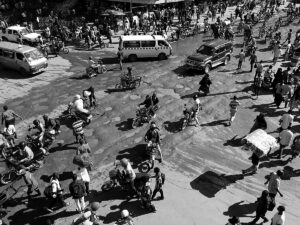From Heart to Border—and Back
When bicycles first reached the green, sprawling city of Kampala on the shores of Lake Victoria, they were used to spread Christianity and enforce colonial law. In tune with cotton’s rocky growth, demand for bicycles spread beyond the chiefly classes in the 1920s to become an instrument for trading goods or cycling to a salaried job. By independence, Kampala was a cycling city, even as cars had become the symbol of wealth.

When dreams of an independent Uganda were dashed in the mid-1970s, bicycle-riding smugglers began to carry people across the border, creating the boda boda bicycle-taxi, transforming the usage of bicycles. Before long motorcycles were introduced in place of bicycles as taxis, further marginalizing what had become a vehicle for the poor and rural. Today, bicycle groups in Kampala are trying to reclaim cycling as a respectable choice, but for most Ugandans they remain a symbol of a left-behind countryside.
In the Kampala chapter of the Cycling Cities: The African Experience, Tom Courtright takes a long look at why bicycles and cycling fell by the wayside as Kampala seeks to affirm itself as a city removed from the rural.